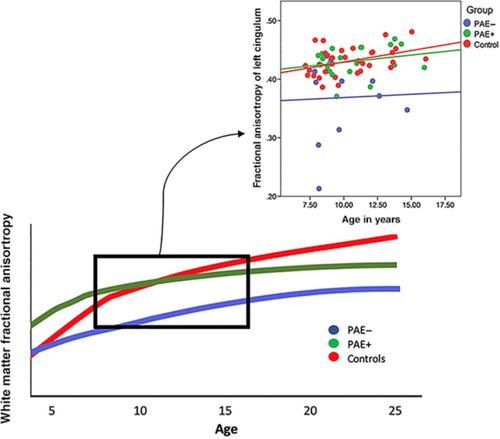当前位置:
X-MOL 学术
›
Hum. Brain Mapp.
›
论文详情
Our official English website, www.x-mol.net, welcomes your
feedback! (Note: you will need to create a separate account there.)
Different brain profiles in children with prenatal alcohol exposure with or without early adverse exposures.
Human Brain Mapping ( IF 3.5 ) Pub Date : 2020-07-13 , DOI: 10.1002/hbm.25130 Quinn R Andre 1, 2, 3 , Carly A McMorris 2, 4 , Preeti Kar 1, 2, 3 , Chantel Ritter 2, 4 , W Ben Gibbard 2, 5 , Christina Tortorelli 6 , Catherine Lebel 2, 3, 7
Human Brain Mapping ( IF 3.5 ) Pub Date : 2020-07-13 , DOI: 10.1002/hbm.25130 Quinn R Andre 1, 2, 3 , Carly A McMorris 2, 4 , Preeti Kar 1, 2, 3 , Chantel Ritter 2, 4 , W Ben Gibbard 2, 5 , Christina Tortorelli 6 , Catherine Lebel 2, 3, 7
Affiliation

|
Prenatal alcohol exposure (PAE) can alter brain development and impact mental health outcomes, and often occurs in conjunction with postnatal adversity (e.g., maltreatment). However, it is unclear how postnatal adverse exposures may moderate mental health and brain outcomes in children with PAE. T1‐weighted and diffusion magnetic resonance imaging were obtained from 66 participants aged 7–16 years. Twenty‐one participants had PAE and adverse postnatal exposures (PAE+), 12 had PAE without adverse postnatal exposures (PAE−), and 33 were age‐ and gender‐matched controls unexposed to either prenatal alcohol or postnatal adversity. Internalizing and externalizing mental health symptoms were assessed using the Behavioral Assessment System for Children II, Parent‐Rating Scale. ANCOVAs were used to compare mental health symptoms, limbic and prefrontal cortical volumes, and diffusion parameters of cortico‐limbic white matter tracts between groups, and to assess brain‐mental health relationships. Both PAE groups had worse externalizing behavior (higher scores) than controls. The PAE− group had lower fractional anisotropy (FA) in the bilateral cingulum and left uncinate fasciculus, and smaller volumes in the left anterior cingulate cortex than controls and the PAE+ group. The PAE− group also had higher mean diffusivity (MD) in the left uncinate than the PAE+ group, and smaller right anterior cingulate and superior frontal gyrus volumes than controls. These findings show different brain structure and mental health symptom profiles in children with PAE with and without postnatal adversity, highlighting the need to consider adverse postnatal exposures in individuals with PAE.
中文翻译:

有或没有早期不良暴露的产前酒精暴露儿童的不同大脑特征。
产前酒精暴露(PAE)可以改变大脑发育并影响心理健康结果,并且通常与产后逆境(例如虐待)一起发生。然而,尚不清楚产后不良暴露如何影响 PAE 儿童的心理健康和大脑结局。从 66 名年龄在 7-16 岁的参与者中获得 T1 加权和弥散磁共振成像。21 名参与者有 PAE 和产后不良暴露(PAE+),12 名有 PAE 没有产后不良暴露(PAE-),33 名是年龄和性别匹配的对照组,未暴露于产前酒精或产后逆境。使用儿童行为评估系统 II,父母评定量表评估内化和外化的心理健康症状。ANCOVA 用于比较心理健康症状,边缘和前额皮质体积,以及组间皮质-边缘白质束的扩散参数,并评估大脑-心理健康关系。两个 PAE 组的外化行为(得分更高)都比对照组更差。与对照组和 PAE+ 组相比,PAE- 组双侧扣带和左钩束的分数各向异性 (FA) 较低,左前扣带皮层的体积更小。PAE-组的左钩骨平均扩散率(MD)也高于PAE+组,右前扣带回和额上回体积也比对照组小。这些研究结果显示了 PAE 儿童在有和没有产后逆境的情况下不同的大脑结构和心理健康症状特征,强调需要考虑 PAE 个体的不良产后暴露。
更新日期:2020-09-21
中文翻译:

有或没有早期不良暴露的产前酒精暴露儿童的不同大脑特征。
产前酒精暴露(PAE)可以改变大脑发育并影响心理健康结果,并且通常与产后逆境(例如虐待)一起发生。然而,尚不清楚产后不良暴露如何影响 PAE 儿童的心理健康和大脑结局。从 66 名年龄在 7-16 岁的参与者中获得 T1 加权和弥散磁共振成像。21 名参与者有 PAE 和产后不良暴露(PAE+),12 名有 PAE 没有产后不良暴露(PAE-),33 名是年龄和性别匹配的对照组,未暴露于产前酒精或产后逆境。使用儿童行为评估系统 II,父母评定量表评估内化和外化的心理健康症状。ANCOVA 用于比较心理健康症状,边缘和前额皮质体积,以及组间皮质-边缘白质束的扩散参数,并评估大脑-心理健康关系。两个 PAE 组的外化行为(得分更高)都比对照组更差。与对照组和 PAE+ 组相比,PAE- 组双侧扣带和左钩束的分数各向异性 (FA) 较低,左前扣带皮层的体积更小。PAE-组的左钩骨平均扩散率(MD)也高于PAE+组,右前扣带回和额上回体积也比对照组小。这些研究结果显示了 PAE 儿童在有和没有产后逆境的情况下不同的大脑结构和心理健康症状特征,强调需要考虑 PAE 个体的不良产后暴露。











































 京公网安备 11010802027423号
京公网安备 11010802027423号